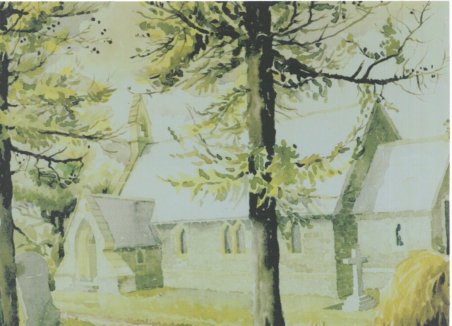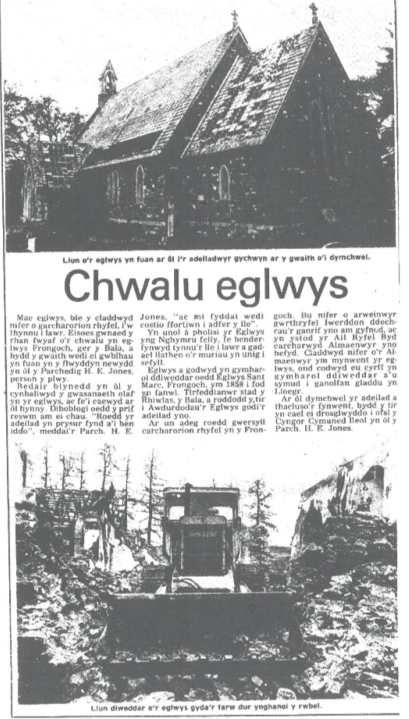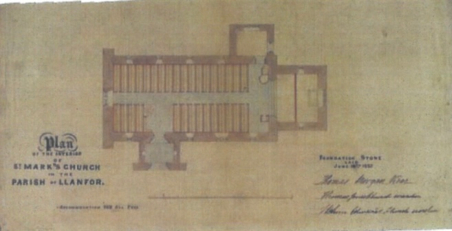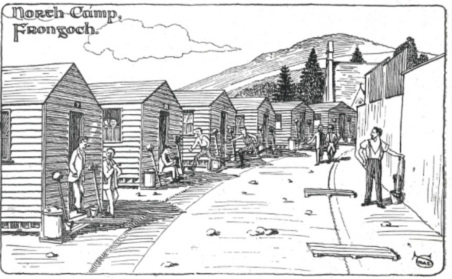Mynwent St. Mark Cemetery


Cyngor Cymuned
Llandderfel
Community Council
Cynghorau Penllyn Councils © 2025 Website designed and maintained by H G Web Designs
Trosglwyddodd yr Eglwys yng Nghymru perchnogaeth y
fynwent i Gyngor Cymuned Llandderfel yn 1986. Cafodd yr
eglwys ei hun ei ddymchwel yn 1978 ond mae hoel yr eglwys
yn amlwg hyd heddiw.
O ran hanes cymdeithasol a gwleidyddol Cymru, mae cyd-
destun adeiladu’r eglwys yn ddiddorol. Codwyd tair eglwys
anwes ym Mhlwyf Llanfor i ychwanegu at eglwysi plwyf
Llanfor a Llandderfel, yn Rhosygwaliau, y Sarnau ac yma yn
Fron-goch. Byddai hyn yn rhan o ymgais gan Frances, gwraig
uchel eglwysig meistr tir Rhiwlas, Richard Watkin Price, i
droi’r brodorion oddi wrth
Ymneilltuaeth. Ynghlwm wrth hyn
i gyd fyddai cosbi tenantiaid am
beidio pleidleisio i’r ymgeisydd
Torïaidd, yn ôl dymuniad Price, yn
cynnwys troi rhai fel Ellis Roberts,
Fferm Fron-goch, o’i fferm.
Adeiladwyd yr eglwys yn y dull
Seisnig Cynnar i ddyluniadau M.
Penson o Gaer. Roedd y cynllun yn
cynnwys cangell a chorff yr eglwys,
festri ogleddol a phorth deheuol,
gyda thalcen cloch orllewinol,
gweler y cynllun isod. Fe'i
cysegrwyd ar 19 Awst 1858. Yn 1909
fe'i hadferwyd. Cafodd ei
dymchwel yn 1978 ac mae hoel yr
eglwys yn amlwg hyd heddiw.
Yn hanesyddol ceir darlun o’r eglwys gan rai o’r Gwyddelod a
garcharwyd yn Fron-goch yn 1916. Gwelir yr eglwys yng
nghefndir un o frasluniau o Wersyll y Gogledd isod. Cyn i’r
Gwyddelod fod yma, ac wedyn, claddwyd rhai carcharorion
rhyfel o’r Almaen a fu farw yn Fron-goch, o dwymyn ac o’r
dicáu er fod gweddillion y cyrff rheini wedi’u symud i
Cannock Chase i fynwent ryfel yr Almaenwyr. Ceir dau gorff
yn yr un bedd i ddau a foddodd yn Llyn Tryweryn yn 1880 yn
ystod yr amser yr adeiledid y rheilffordd drwy Fron-goch o’r
Bala i Ffestiniog.
Ownership of the cemetery was transferred to Llandderfel
Community Council from the Church in Wales in 1986. The
church itself was demolished in 1978 but traces of the walls
are still visible today.
In terms of the social and political history of Wales, the
context of the construction of the church is interesting. Three
churches were built in the Llanfor Parish, Rhosygwaliau, y
Sarnau and here in Fron-goch to add to the Llanfor and
Llandderfel parish churches. This was part of an attempt by
Frances, the ecclesiastical wife of the Rhiwlas landowner,
Richard Watkin Price, to turn
the locals away from
Secession. Examples of this
was punishing tenants for not
following Price’s wishes and
not voting for the Tory
candidate, including evicting
Ellis Roberts, Fron-goch Farm,
from his farm. The church was
built in the Early English style
to the designs of M. Penson of
Chester. The plan included a
chancel and nave, north
vestry and south porch, with a
west bell gable, see plan
below. It was consecrated on
the 19th of August 1858 and
restored in 1909.
Historically, the church appears in some of the drawings
made by the Irish imprisoned in Fron-goch in 1916. The
church can be seen in the background of one of the sketches
of the North Camp below. Before the Irish were here, and
afterwards, some German prisoners of war who died in Fron-
goch, of fever and the ticks, were buried here. Later, the
remains of those bodies were moved to the German war
cemetery in Cannock Chase. Also, there is grave for two who
drowned in Llyn Tryweryn in 1880, during the time the railway
was being built through Fron-goch from Bala to Ffestiniog.




Erthygl o bapur newydd Y Cyfnod 1978.
Article from the local newspaper Y Cyfnod 1978.
Gwelir yr eglwys yng nghefndir un o frasluniau o Wersyll y Gogledd
gan on o’r Gwyddelod a garcharwyd yn Fron-goch yn 1916.
The church can be seen in the background of a sketch of the North
Camp by one of the Irish imprisoned in Fron-goch in 1916.
Cynllun yr eglwys.
Church floorplan.
Mynwent St. Mark Cemetery

Cyngor Cymuned
Llandderfel
Community Council
Cynghorau Penllyn Councils © 2025
Website designed and maintained by H G Web Designs
Trosglwyddodd yr Eglwys yng Nghymru perchnogaeth y
fynwent i Gyngor Cymuned Llandderfel yn 1986. Cafodd yr
eglwys ei hun ei ddymchwel yn 1978 ond mae hoel yr eglwys
yn amlwg hyd heddiw.
O ran hanes cymdeithasol a gwleidyddol Cymru, mae cyd-
destun adeiladu’r eglwys yn ddiddorol. Codwyd tair eglwys
anwes ym Mhlwyf Llanfor i ychwanegu at eglwysi plwyf
Llanfor a Llandderfel, yn Rhosygwaliau, y Sarnau ac yma yn
Fron-goch. Byddai hyn yn rhan o ymgais gan Frances, gwraig
uchel eglwysig meistr tir Rhiwlas, Richard Watkin Price, i
droi’r brodorion oddi wrth Ymneilltuaeth. Ynghlwm wrth hyn i
gyd fyddai cosbi tenantiaid am beidio pleidleisio i’r
ymgeisydd Torïaidd, yn ôl dymuniad Price, yn cynnwys troi
rhai fel Ellis Roberts, Fferm Fron-goch, o’i fferm. Adeiladwyd
yr eglwys yn y dull Seisnig Cynnar i ddyluniadau M. Penson o
Gaer. Roedd y cynllun yn cynnwys cangell a chorff yr eglwys,
festri ogleddol a phorth deheuol, gyda thalcen cloch
orllewinol, gweler y cynllun isod. Fe'i cysegrwyd ar 19 Awst
1858. Yn 1909 fe'i hadferwyd. Cafodd ei dymchwel yn 1978 ac
mae hoel yr eglwys yn amlwg hyd heddiw.
Yn hanesyddol ceir darlun o’r eglwys gan rai o’r Gwyddelod a
garcharwyd yn Fron-goch yn 1916. Gwelir yr eglwys yng
nghefndir un o frasluniau o Wersyll y Gogledd isod. Cyn i’r
Gwyddelod fod yma, ac wedyn, claddwyd rhai carcharorion
rhyfel o’r Almaen a fu farw yn Fron-goch, o dwymyn ac o’r
dicáu er fod gweddillion y cyrff rheini wedi’u symud i
Cannock Chase i fynwent ryfel yr Almaenwyr. Ceir dau gorff
yn yr un bedd i ddau a foddodd yn Llyn Tryweryn yn 1880 yn
ystod yr amser yr adeiledid y rheilffordd drwy Fron-goch o’r
Bala i Ffestiniog.
Ownership of the cemetery was transferred to Llandderfel
Community Council from the Church in Wales in 1986. The
church itself was demolished in 1978 but traces of the walls
are still visible today.
In terms of the social and political history of Wales, the
context of the construction of the church is interesting. Three
churches were built in the Llanfor Parish, Rhosygwaliau, y
Sarnau and here in Fron-goch to add to the Llanfor and
Llandderfel parish churches. This was part of an attempt by
Frances, the ecclesiastical wife of the Rhiwlas landowner,
Richard Watkin Price, to turn the locals away from Secession.
Examples of this was punishing tenants for not following
Price’s wishes and not voting for the Tory candidate, including
evicting Ellis Roberts, Fron-goch Farm, from his farm. The
church was built in the Early English style to the designs of M.
Penson of Chester. The plan included a chancel and nave,
north vestry and south porch, with a west bell gable, see plan
below. It was consecrated on the 19th of August 1858 and
restored in 1909.
Historically, the church appears in some of the drawings
made by the Irish imprisoned in Fron-goch in 1916. The
church can be seen in the background of one of the sketches
of the North Camp below. Before the Irish were here, and
afterwards, some German prisoners of war who died in Fron-
goch, of fever and the ticks, were buried here. Later, the
remains of those bodies were moved to the German war
cemetery in Cannock Chase. Also, there is grave for two who
drowned in Llyn Tryweryn in 1880, during the time the railway
was being built through Fron-goch from Bala to Ffestiniog.




Erthygl o bapur newydd Y Cyfnod 1978.
Article from the local newspaper Y Cyfnod 1978.
Gwelir yr eglwys yng nghefndir un o frasluniau o Wersyll y Gogledd
gan on o’r Gwyddelod a garcharwyd yn Fron-goch yn 1916.
The church can be seen in the background of a sketch of the North
Camp by one of the Irish imprisoned in Fron-goch in 1916.
Cynllun yr eglwys.
Church floorplan.















